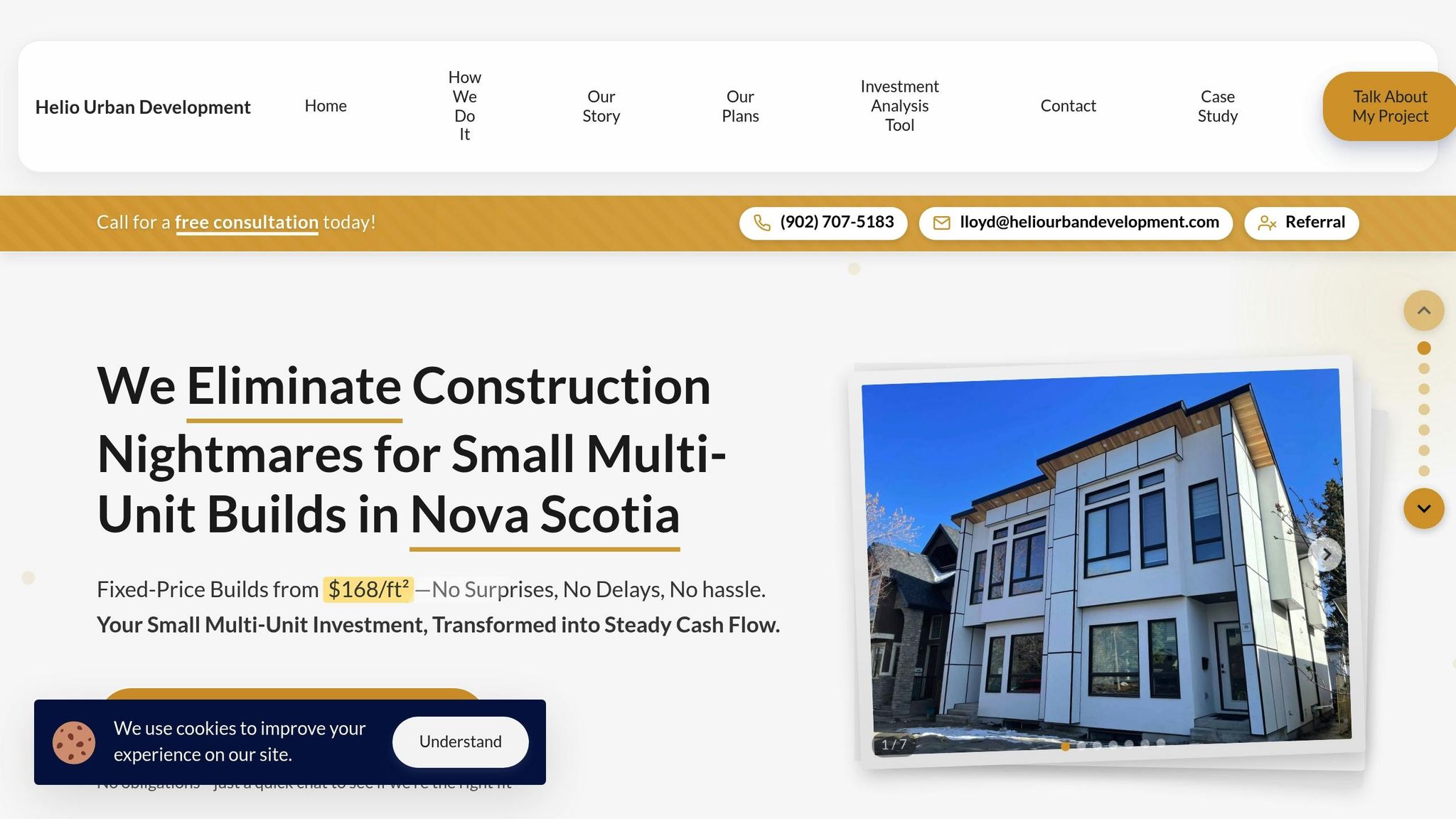Protecting air quality during construction in Nova Scotia is essential for public health, the environment, and compliance with strict regulations. Here's what you need to know:
- Key Regulations: Projects must follow the Environment Act, Canadian Ambient Air Quality Standards (CAAQS), and obtain permits like Environmental Assessments, Air Quality Permits, and Dust Control Plans.
- Pollution Control: Manage emissions (PM2.5, PM10, NOₓ, SO₂) with measures like dust suppression, equipment maintenance, and limiting idling times.
- Monitoring Requirements: Sites over 2 hectares need monitoring stations, daily air quality readings, and monthly reports to Nova Scotia Environment and Climate Change (NSECC).
- Business Benefits: Compliance can lead to cost savings, better project timelines, and increased property value through green building certifications.
How To Control Dust On Construction Sites
Nova Scotia Air Quality Laws
In Nova Scotia, the construction industry operates under strict air quality rules aimed at protecting both public health and the natural surroundings. These regulations are part of the province's broader efforts to manage air quality responsibly.
Key Laws and Standards
Construction projects must adhere to several important regulations, including the Environment Act, air quality-specific rules, the Canadian Ambient Air Quality Standards (CAAQS), and detailed construction guidelines. These regulations set clear limits on pollutants and outline steps to reduce emissions. They also play a key role in monitoring air pollutants on construction sites.
Controlled Air Pollutants
Construction activities must manage emissions of pollutants like fine particulate matter (PM2.5), coarse particulate matter (PM10), nitrogen oxides (NOₓ), and sulphur dioxide (SO₂). Common tasks such as earthmoving, operating heavy machinery, demolition, and cutting concrete are major sources of these emissions, making effective control measures essential.
Meeting Air Quality Rules
Construction projects in Nova Scotia must follow specific air quality regulations. A key part of this process is obtaining the necessary permits and adhering to established standards.
Required Permits
Before breaking ground, several permits must be secured through Nova Scotia Environment and Climate Change (NSECC). These include:
- Environmental Assessment Approval: Required for projects larger than 4 hectares.
- Air Quality Permit: Necessary for sites using equipment that produces substantial emissions.
- Dust Control Plan: Must be submitted and approved before starting construction activities.
Projects need to provide detailed documentation on emission sources, control methods, and monitoring plans. Since approvals can take 60–90 days, it’s important to apply well in advance.
Testing and Reports
Once permits are approved, continuous air quality monitoring is mandatory. Construction sites are required to:
- Set up monitoring stations along the site boundaries.
- Take daily particulate matter (PM) readings.
- Track wind conditions and log all air quality data.
- Submit monthly compliance reports to NSECC.
Monitoring equipment must comply with Canadian Standards Association (CSA) standards and be routinely calibrated. For sites over 2 hectares, at least two monitoring stations are required, placed at opposite corners of the site.
Site Pollution Control
Proper site management involves a range of measures to limit pollution:
Equipment Controls
- Use Tier 4-compliant construction equipment.
- Follow manufacturer guidelines for engine maintenance.
- Restrict idling times to no more than 3 minutes.
- Install diesel particulate filters on heavy machinery.
Material Management
- Cover stockpiles with tarps or erosion control blankets.
- Use water sprays during demolition to control dust.
- Install wheel wash stations at site exits.
- Apply dust suppressants on unpaved surfaces.
Work Practice Controls
- Schedule high-emission tasks during periods of low wind.
- Maintain a 15-metre buffer zone around sensitive areas.
- Enforce speed limits of 15 km/h on-site with visible signage.
- Train workers on proper equipment use and maintenance.
These measures are part of the broader Air Quality Management Plan, which ensures construction practices align with air quality requirements.
sbb-itb-16b8a48
Reducing Air Pollution on Site
In addition to required pollution controls, these strategies can help further cut down on emissions during on-site activities.
Dust and Emission Controls
Physical barriers and modernized equipment are key to managing dust and emissions effectively. Consider measures like dust screens, misting systems, gravel pads at site entrances, and wind fencing to limit airborne particles. Upgrading equipment with features such as high-efficiency filters, sealed material transfer systems, dust extraction tools, and pressurized cabs can also significantly reduce emissions.
Air Quality Management Plans
A well-designed Air Quality Management Plan should address the unique conditions of each site. These plans include details on monitoring station placement, data collection methods, and response protocols for when air quality thresholds are exceeded. They also cover dust suppression techniques, equipment maintenance schedules, material handling procedures, and emergency protocols. When combined with thoughtful scheduling, these plans can make a noticeable difference in maintaining better air quality on site.
Work Timing and Planning
Careful planning of work schedules can help limit air pollution during construction. For instance, Helio Urban Development uses AI-based task sequencing to streamline construction timelines and reduce downtime [1]. Minimise equipment idle time and schedule high-emission tasks during times of favourable weather. Pay attention to wind conditions and adjust work accordingly. This approach not only keeps projects compliant with regulations but also demonstrates a strong commitment to protecting community health.
Business Advantages of Clean Air Rules
Managing air quality effectively isn't just about meeting regulations - it can also bring real business benefits.
Green Building Benefits
Following air quality regulations during construction does more than ensure compliance. It can also improve a project's reputation. Showing a commitment to cleaner air can attract environmentally aware tenants and buyers. Plus, properties designed with air quality in mind may qualify for green building certifications. These certifications can increase property values and make it easier to market units for sale or lease.
Cost Savings and Incentives
Managing air quality can also save money. For example, Helio Urban Development uses an AI-driven scheduling system that can speed up project timelines by up to two months. This faster turnaround can lead to quicker equity gains and better financial outcomes [1]. These benefits highlight the economic value of prioritizing air quality in construction.
Helio Urban Development's Compliance Approach

Helio Urban Development takes compliance a step further by turning it into a competitive edge. Their fixed-price construction model, starting at $168 per square foot, integrates design and scheduling to reduce air quality impacts while maximizing project returns [1].
"Having a guaranteed price was everything for my first project. Helio took me from day-one design through lease-up, all without the hidden costs I dreaded. I couldn't have asked for a smoother introduction to development."
– Michael T., New Developer [1]
Their focus on efficiency is evident in a recent 4-plex project that reached full occupancy before it was even completed, generating $9,600 in monthly rental income [1].
| Project Type | Timeline | Cost per sq. ft. | Financial Impact |
|---|---|---|---|
| Short-term Rental | 10 months | $184 | $8,700/month revenue |
| Duplex | 7 months | $165 | $231,000 in equity |
| 4-Plex | 9 months | $173 | $9,600/month revenue |
These examples show how focusing on compliance can lead to both environmental and financial benefits for construction projects in Nova Scotia.
Conclusion
Nova Scotia's air quality regulations play a key role in successful project development and earning community trust. Projects that focus on maintaining clean air not only meet regulatory requirements but also contribute to long-term gains, such as increased property values and stronger stakeholder relationships.
Helio Urban Development showcases how adhering to strict environmental standards can go hand in hand with efficient project management and positive market results [1].
For construction companies, treating air quality compliance as an opportunity rather than a challenge can lead to success in Nova Scotia's changing landscape. By incorporating air quality measures from the planning stages through to project completion, companies can create healthier communities, strengthen regulatory and community relationships, and deliver better overall outcomes.



